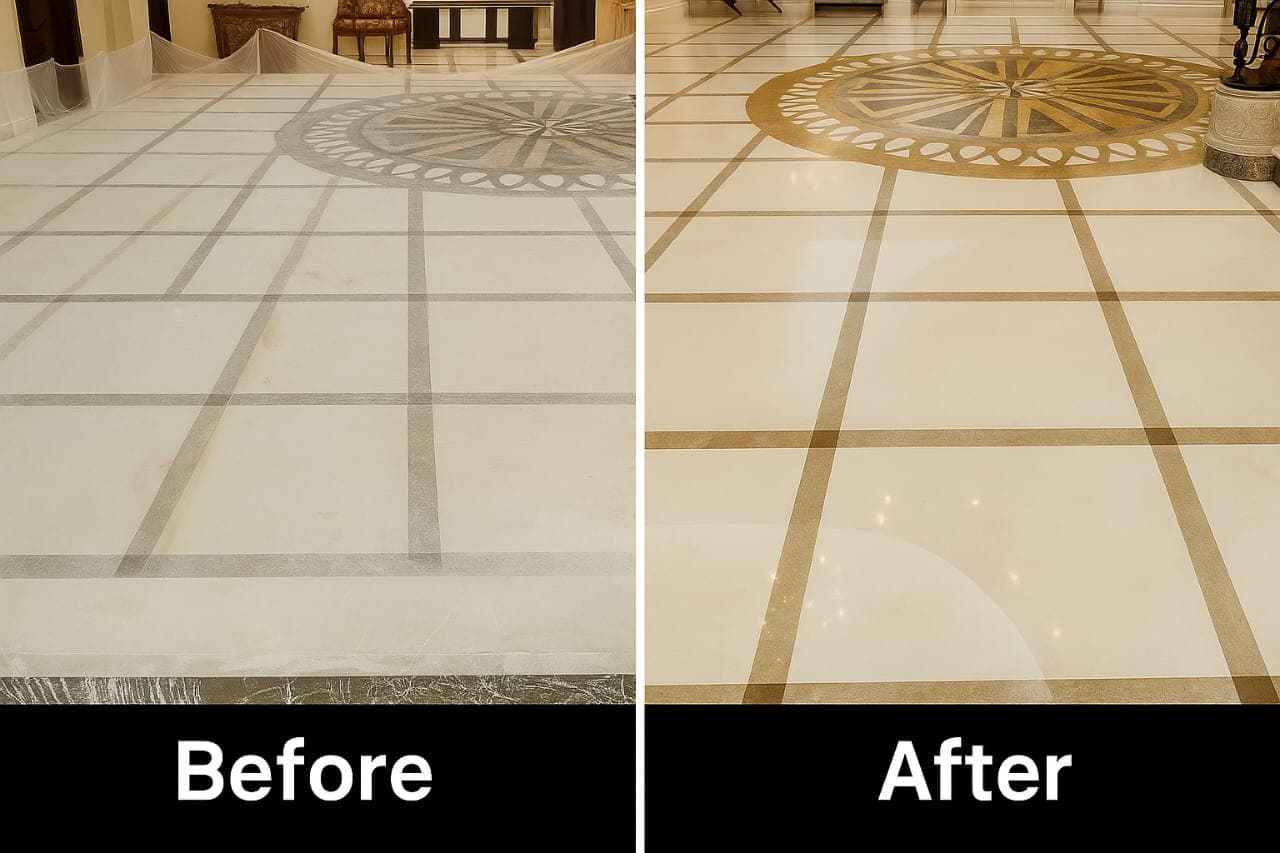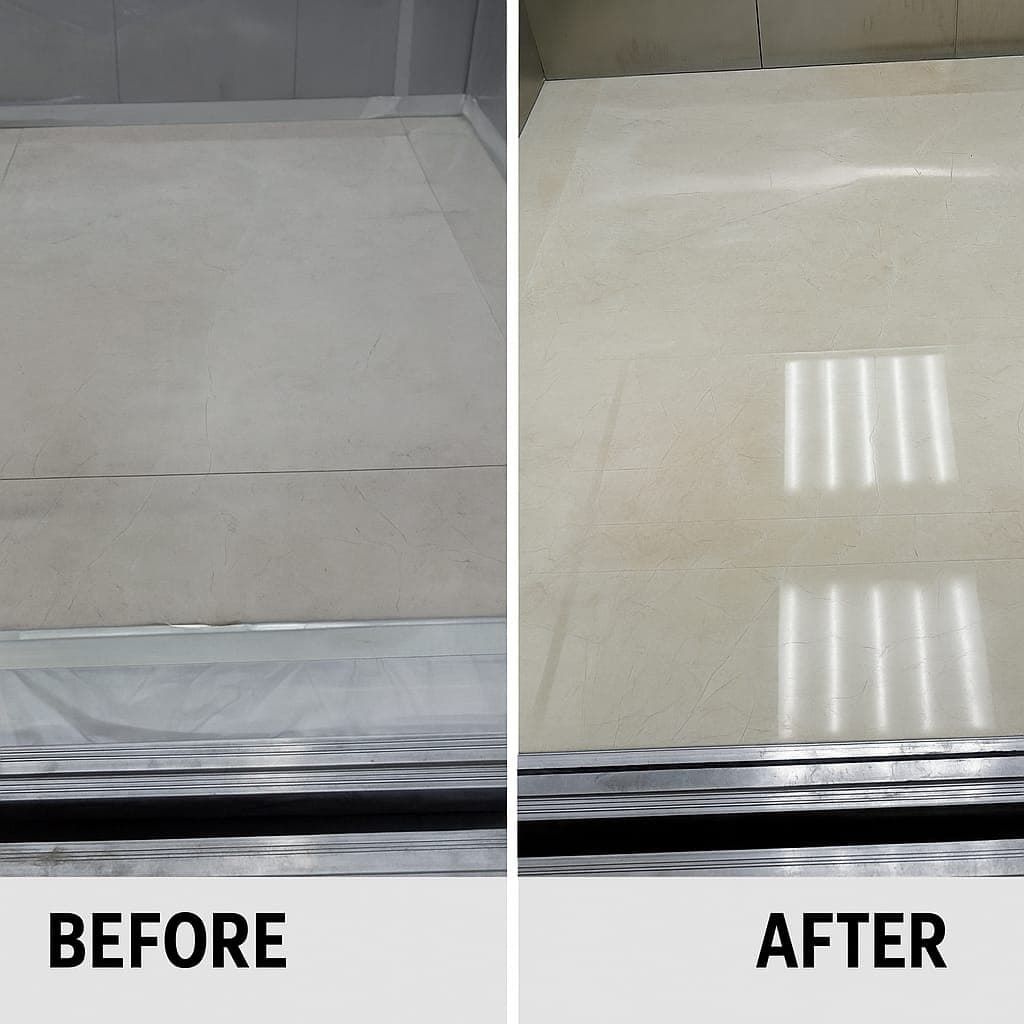Marble Polishing in Dubai: The Complete Guide to Longer-Lasting Shine
Marble polishing in Dubai is the smartest way to revive dull floors, remove scratches, and protect a premium investment. From villas in Palm Jumeirah to offices in Business Bay, marble delivers a luxury look—but Dubai’s sand, humidity, and heavy footfall can wear it down quickly. This guide explains why marble loses its shine, what a professional restoration includes, and exactly how to maintain a brilliant finish for years.
If your floors look cloudy or etched, professional marble polishing and restoration services in Dubai can reset the surface safely. Below you’ll find the step-by-step process, cost and time factors, before/after examples, and a printable care calendar—everything you need to make the right decision.
Why Floors Need Marble Polishing in Dubai
- Micro-scratches from sand: Wind-blown grit and everyday shoes act like fine sandpaper, dulling the surface.
- Acid etching: Lemon, cola, vinegar, or harsh cleaners react with calcite in marble and create matte “burn” marks.
- Spills & stains: Marble is porous; coffee, oil, or rust can soak in if not sealed or wiped quickly.
- Moisture & mopping habits: Too much water or dirty mops leave residue and haze.
- Uneven tiles (lippage): Raised edges catch dirt and reflect light poorly, making floors look old even when clean.
Quick reference on the stone’s composition: what marble is and why it etches.
What Professional Marble Polishing in Dubai Includes
A proper restoration uses industrial machines, diamond abrasives, water control, and experienced technicians. The sequence:
- Survey & moisture check: Identify stains, etch marks, hollow sounds, cracks, and lippage. Choose pads, grits, and chemicals accordingly.
- Protection & containment: Mask skirtings, columns, lifts; isolate with caution tape; set up wet vacs for slurry control.
- Grinding (lippage removal): Coarse diamonds flatten high edges and remove deep wear lines. This step restores a level plane.
- Honing: Multiple passes with medium-to-fine diamonds refine scratches and open the stone evenly.
- Polishing: High-grit diamonds and polishing powders/crystallization bring clarity and reflectivity back.
- Detailing & edges: Hand tools reach corners, thresholds, and under fixtures for a consistent finish.
- Sealing: A breathable, penetrating sealer reduces water and oil absorption without making the floor slippery.
- Final inspection & aftercare briefing: Light testing with gloss meters or visual checks; client walk-through and care guide.
DIY shortcuts often overheat the stone, create swirl marks, or trap slurry—costing more to fix later. Certified teams prevent those risks.
Choosing the Right Marble Finish for Your Space
High-gloss: Maximum reflectivity; ideal for lobbies and showrooms. Shows scratches sooner—needs regular maintenance.
Satin/semi-gloss: Balanced look; hides traffic better than mirror polish; great for homes and corridors.
Honed/matte: Low glare, modern aesthetic, more slip-resistant; popular in kitchens and outdoor-adjacent areas.
Your technician will recommend a finish based on traffic, lighting, stone type (Carrara, Crema Marfil, Emperador, etc.), and safety requirements.
Cost and Time Factors for Marble Polishing in Dubai
- Area & accessibility: Total square meters, floor level, parking/loading access.
- Condition: Deep scratches, stains, or heavy lippage require more stages and passes.
- Stone type & hardness: Some marbles need slower, finer steps to avoid orange peel or micro-pitting.
- Desired finish: Mirror gloss takes longer than a honed or satin finish.
- Protection & sealing: Premium sealers or color-enhancers add cost but extend maintenance cycles.
- Working window: Night work or urgent turnaround can require extra manpower and machines.
A professional site visit produces an accurate BOQ and method statement—vital for hotels, malls, and FM contracts.
Real Results: Before & After Marble Polishing in Dubai


Our certified team completed grinding, honing, polishing, and sealing for durable protection and a premium shine. This is the difference a correct, multi-stage restoration makes.
Maintenance Calendar: Keep the Shine Longer
Daily
- Dry mop with microfiber to remove sand and dust.
- Wipe spills immediately—especially acidic drinks.
Weekly
- Damp mop using a pH-neutral marble cleaner; avoid vinegar/bleach.
- Check high-traffic paths; place rugs at entrances.
Quarterly
- Do a visual inspection under daylight: look for etch spots, scuffs, or haze.
- Book a light repolish/crystallization for hotels, retail, and heavy-use lobbies.
Annually
- Residential: schedule a full polish every 12–18 months.
- Commercial: plan 3–6-monthly cycles based on footfall and finish level.
Common DIY Mistakes (and How We Avoid Them)
- Acidic cleaners for “extra shine”: they etch the surface—shine drops further.
- Over-the-counter waxes: temporary gloss that yellows and traps dirt; removal is messy and costly.
- Skipping lippage removal: polishing uneven tiles magnifies shadows and reflections.
- Dry polishing: overheats stone and causes swirl marks; we use controlled water and proper speeds.
- No sealing: leaves pores open to stains; we apply a breathable penetrating sealer.
Where Marble Polishing in Dubai Delivers the Biggest ROI
Luxury villas & apartments: Kitchens, living rooms, and staircases benefit from safer finishes and easy cleaning.
Hotels & serviced residences: First impressions start at the lobby. A consistent gloss supports brand standards and reviews.
Retail & showrooms: High reflectivity boosts product presentation and lighting efficiency.
Offices & clinics: Smooth, sealed floors reduce dust, helping hygiene and air quality.
Top Benefits of Professional Marble Polishing
- ✅ Restores natural color, depth, and clarity
- ✅ Removes scratches and etch marks the right way
- ✅ Easier daily cleaning and better hygiene
- ✅ Extends floor life and postpones costly replacement
- ✅ Enhances property value and guest perception
How Often Should You Book Marble Polishing in Dubai?
Residential: every 12–18 months; for high-traffic rooms (kitchen, corridors) every 6–12 months.
Commercial: every 3–6 months; lobbies or F&B areas may need monthly touch-ups.
The right schedule depends on foot traffic, finish level, cleaning practices, and stone type.
Book Professional Marble Polishing in Dubai
17+ years’ experience • Certified technicians • Hotel & luxury villa ready
Marble Polishing in Dubai — FAQs
How long does a typical job take?
A 30–40 m² living room usually takes 4–6 hours including sealing. Large lobbies or heavy restoration may require a full day or two with multiple machines.
Will polishing remove deep scratches and stains?
Deep scratches are removed during grinding and honing. Most stains lighten significantly after resurfacing and sealing; rust or oil may need spot poultice treatment.
Is the process dusty or noisy?
We use wet polishing with slurry collection to minimize dust. Noise is comparable to a vacuum/cleaning machine and is managed during agreed work windows.
Will the floor be slippery after polishing?
A mirror finish is naturally smoother, but correct cleaning and a quality penetrating sealer keep traction predictable. For ramps or wet zones, consider a satin/honed finish.
How soon can we walk on the floor?
Light foot traffic is usually fine immediately after polishing. If sealed, allow the sealer’s stated cure time (often 2–6 hours for light use; full cure may be 24 hours).
